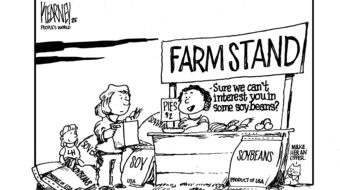WASHINGTON (PAI) – If you walk into Los Angeles International Airport (LAX) next year, you won’t find a McDonald’s.
They refused to pay their workers a living wage, and dropped out of the bidding for a restaurant concession at LAX, says Madeline Janis, executive director of the L.A. Alliance For a New Economy – who is also a city redevelopment agency commissioner.
Why? McDonald’s wanted to pay its workers the minimum wage, not the living wage that a city ordinance mandates. But the chain is the exception at LAX, not the rule. As a result, the ordinance at the airport is a good one for workers there, Janis told a Nov. 30 symposium hosted by the Center for American Progress.
Other restaurant chains weren’t afraid to bid for Los Angeles airport food court slots and were willing to pay the workers the living wage – typically $10-$14 hourly plus benefits – she added. Both businesses and workers benefited. Airport food court sites are very profitable. And 20,000 families rose out of poverty via living wage jobs at LAX.
“They’re not middle-class jobs, but they put food on the table, let the parents buy their kids school supplies, the families can pay the rent and they have an old car,” Janis said at the center’s Washington, D.C., symposium on living wage ordinances.
Janis’ evidence was backed by a new report by University of North Carolina city planning professor William Lester. He examined 15 cities with living wage ordinances – which have been strongly pushed by organized labor for the last decade or more – with a “control group” of 16 cities, with similar socioeconomic characteristics, where the ordinances were either never proposed or defeated at the polls or in city councils.
His object was to see if there was any negative economic impact of the living wage ordinances, in terms of driving businesses out of the “living wage” cities or deterring them from entering, as living wage foes – usually led by local Chambers of Commerce-claim. Lester found virtually none.
Instead, his study showed two positive effects from living wage ordinances, one for workers and one for businesses. The workers’ wages rose, and businesses saw their job turnover decline by 20%. “You get higher-quality labor,” Lester added. “I predict the living wage movement will spread, especially as the evidence grows that it’s not a job-killer,” he declared.
The Chamber of Commerce representative on the panel said that living wage ordinances could help workers, but defended the business group’s contention that they also cost jobs. “Making employees more expensive is not a strategy for spurring economic activity,” he said.
But he also said the U.S. Chamber leaves local living wage support or opposition decisions to local affiliates. He admitted that some businesses – in the construction industry-have been living with a “living wage” law for almost 80 years. It’s called the Davis-Bacon Act. But “the market should set wage rates,” he said.








